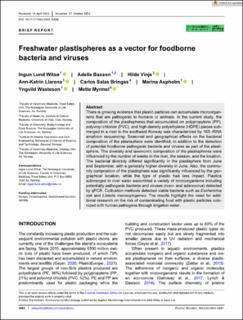| dc.contributor.author | Witsø, Ingun Lund | |
| dc.contributor.author | Basson, Adelle | |
| dc.contributor.author | Vinje, Hilde | |
| dc.contributor.author | Llarena, Ann-Katrin | |
| dc.contributor.author | Salas Bringas, Carlos Mauricio | |
| dc.contributor.author | Aspholm, Marina | |
| dc.contributor.author | Wasteson, Yngvild | |
| dc.contributor.author | Myrmel, Mette | |
| dc.date.accessioned | 2024-02-08T06:57:48Z | |
| dc.date.available | 2024-02-08T06:57:48Z | |
| dc.date.created | 2023-11-15T15:12:43Z | |
| dc.date.issued | 2023 | |
| dc.identifier.issn | 1462-2912 | |
| dc.identifier.uri | https://hdl.handle.net/11250/3116269 | |
| dc.description.abstract | There is growing evidence that plastic particles can accumulate microorganisms that are pathogenic to humans or animals. In the current study, the composition of the plastispheres that accumulated on polypropylene (PP), polyvinyl chloride (PVC), and high-density polyethylene (HDPE) pieces submerged in a river in the southeast Norway was characterized by 16S rRNA amplicon sequencing. Seasonal and geographical effects on the bacterial composition of the plastisphere were identified, in addition to the detection of potential foodborne pathogenic bacteria and viruses as part of the plastisphere. The diversity and taxonomic composition of the plastispheres were influenced by the number of weeks in the river, the season, and the location. The bacterial diversity differed significantly in the plastisphere from June and September, with a generally higher diversity in June. Also, the community composition of the plastisphere was significantly influenced by the geographical location, while the type of plastic had less impact. Plastics submerged in river water assembled a variety of microorganisms including potentially pathogenic bacteria and viruses (noro- and adenovirus) detected by qPCR. Cultivation methods detected viable bacteria such as Escherichia coli and Listeria monocytogenes. The results highlight the need for additional research on the risk of contaminating food with plastic particles colonized with human pathogens through irrigation water. | en_US |
| dc.language.iso | eng | en_US |
| dc.publisher | Applied Microbiology International and John Wiley & Sons Ltd. | en_US |
| dc.rights | Navngivelse 4.0 Internasjonal | * |
| dc.rights.uri | http://creativecommons.org/licenses/by/4.0/deed.no | * |
| dc.title | Freshwater plastispheres as a vector for foodborne bacteria and viruses | en_US |
| dc.title.alternative | Freshwater plastispheres as a vector for foodborne bacteria and viruses | en_US |
| dc.type | Peer reviewed | en_US |
| dc.type | Journal article | en_US |
| dc.description.version | publishedVersion | en_US |
| dc.source.pagenumber | 2864-2881 | en_US |
| dc.source.volume | 25 | en_US |
| dc.source.journal | Environmental Microbiology | en_US |
| dc.source.issue | 12 | en_US |
| dc.identifier.doi | 10.1111/1462-2920.16536 | |
| dc.identifier.cristin | 2197200 | |
| dc.relation.project | Norges forskningsråd: 302996 | en_US |
| cristin.ispublished | true | |
| cristin.fulltext | original | |
| cristin.qualitycode | 2 | |

